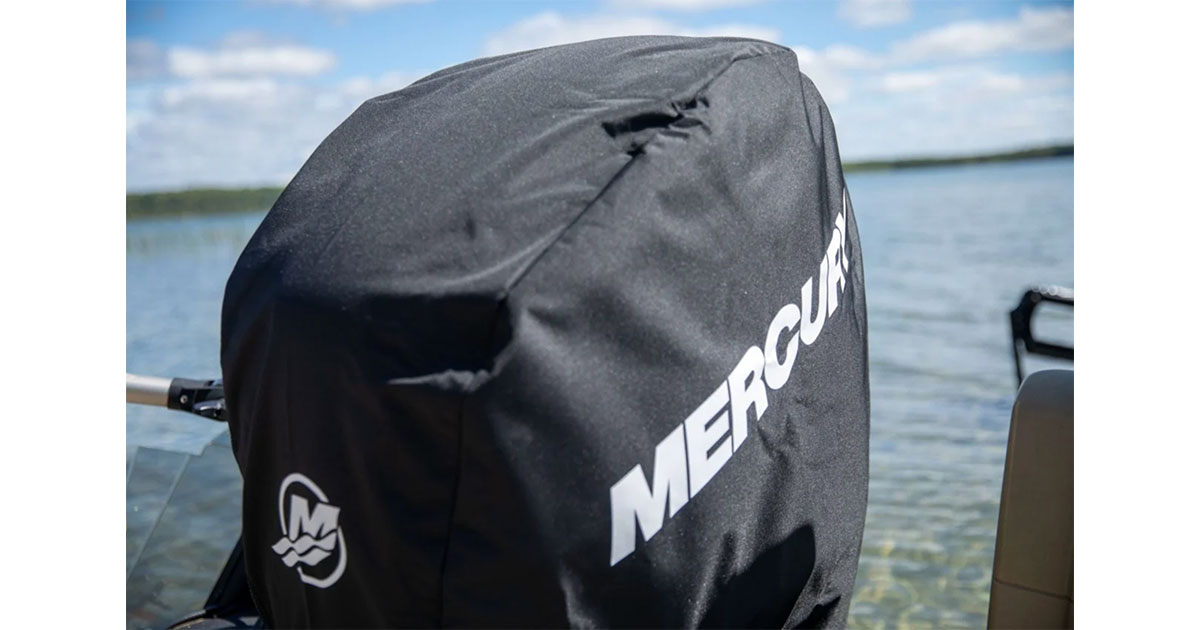- Details
By Louie Stout
Mercury Report

Propellers for pleasure boats with outboard or sterndrive power are made from one of two materials: aluminum or stainless steel. Let’s look at the advantages each offers.
Aluminum Propellers
Affordability is the key advantage of an aluminum prop. The price of the material and the manufacturing process allow a Mercury® aluminum propeller such as the Black Max® or SpitFire® to cost as little as one-third the price of a similar stainless steel propeller.
- Details
Mercury Report

The look of a Mercury outboard is classic and unmistakable. If you want to make sure that legendary look stays showroom sharp for as long as possible, then consider a genuine Mercury engine cover, also known as a cowl cover, to protect it on the water, while trailering and in storage.
But since Mercury cowls are strong and durable, why would you need a cover? The fact is, the marine environment is not gentle on our equipment. Sun, salt, tow ropes, docks, tree branches, and fishing lures all take a toll on the surfaces of your boat and engine over time, and the best way to keep the cowl – the most visible part of your engine – from getting scratches and dings is a cowl cover.
Mercury offers two types. Mercury Vented Splash Covers are designed for use while running the outboard. They’re made of Polysoft, a specially designed marine-grade fabric, and are crafted to form fit over your Mercury outboard cowl, with perfectly placed vents to allow for proper airflow. Mercury Tow-n-Stow Storage Covers are similarly made but are intended for towing and storage, with a leg strap that helps hold them firmly in place. Both cover types proudly display Mercury graphics that correspond with the matched engine model, and each is lined with soft felt to be as gentle as possible on your engine’s gloss finish.
A Vented Splash Cover is quick and easy to install and remove. Just slip it on right before you launch the boat for a good look and extra protection during your day on the water. It’s not designed for trailering or storage, so once your boat is back on the trailer or boat lift, pull the cover off and replace it with a Tow-n-Stow Storage Cover. While you wash your boat, don’t forget to rinse off your cowl cover with clean water before hanging it up to dry.
Using a Tow-n-Stow Storage Cover on the road helps protect your engine against flying gravel and other road debris, as well as the unsightly buildup of bugs. During storage, the cover will guard against wear and tear from birds, severe weather, UV sun damage, and even the errant bicycle in the driveway. It’ll also help keep dust and rodents at bay.
Mercury engine covers are model-specific and are available at Mercury authorized dealers or online in the Mercury Dockstore. Vented Splash Covers for running are available for most Mercury outboards 75hp and above. Tow-n-Stow Storage Covers are available for most models 40hp and larger. Custom covers are also available.
Granted, your time on the water might consist of sedate sunset cruises and you could be lucky enough to have indoor storage for your boat, in which case an engine cover might not be necessary. But if you do have concerns about the long-term effects of the elements on the looks of your engine, it’s certainly worth considering investing in genuine Mercury covers to ensure that you have maximum protection.
- Details
Newport Report Newport Vessels has announced the launch of the NS130, a high-performance inflatable skiff designed for anglers seeking the perfect blend of portability, stability, and versatility. Priced at an MSRP of $2,299 and backed by a 2-year warranty, the NS130 is set to redefine what it means to have on-demand access to premium fishing experiences, no matter where you fish. The NS130 features an elevated, adjustable swivel seat, plentiful grab handles for effortless portages, and track mounting boards and horizontal rod rests for convenient gear management. Its high-performance, inflatable construction provides the stability and durability of a rigid-hull design while ensuring ease of transport and setup. With track mounting boards, sub-floor wire management, and a spacious open-cockpit layout, anglers can focus on what matters most—catching fish. "This product offers unparalleled versatility and portability, says Howie Strech of Newport. Whether you’re packing it fully rigged into a truck bed or carrying it to your favorite off-grid fishing spot and inflating it at the shoreline, the NS130 makes the entire journey effortless." The NS130’s design includes a low-drag, tapered catamaran hull optimized for use with Newport electric outboards, ensuring speed and precision in navigating a variety of waters. Built with hot-welded seams, an EVA floor, and marine-grade transom, it withstands the toughest conditions while maintaining performance and safety. “We've engineered the NS130 to be as rugged as it is responsive,” Jason Kardas, Head of Product Development, "Every feature, from the rub-rails to the five-chamber design and robust material choices, has been thoughtfully integrated to meet the demands of serious anglers who need reliability in harsh environments." Its lightweight, packable design makes it perfect for anglers who value mobility without compromising on performance. The NS130 Inflatable Skiff is available at https://newportvessels.com/products/ns130-inflatable-skiff and through specialty retail locations. For a video detailing the Skiff, click here. Newport Skiff
Newport Skiff
- Details
Mercury Report Kicker motors are a big benefit for many fishing applications, and Mercury has motors in its ProKicker™ lineup. ProKicker outboards are purpose-built for low-speed trolling. They make it easy to dial in a trolling speed down to a tenth of a mile per hour and then repeat that speed again and again with fish-catching accuracy. If you’re an angler wondering if you need a kicker, or you’re wondering how to get the most fishing performance out of a kicker motor, here’s a helpful overview. What is a kicker motor? A kicker is a small auxiliary outboard motor that’s mounted next to the main outboard on a boat’s transom. A kicker’s primary application is for trolling at speeds ranging from about 0.8 to 3 mph for walleyes, crappie, salmon, lake trout, muskies and other freshwater species. There are also some saltwater applications. Each model in the Mercury ProKicker lineup comes standard with convenient features like power tilt, electric start and electronic fuel injection (EFI) for reliable starts in all weather conditions. They also feature a high-thrust four-blade prop and a gear ratio optimized for low-speed fishing. Mercury kicker motor
Mercury kicker motor
- Details





